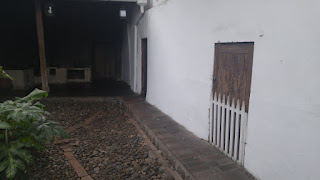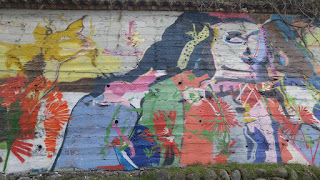{Artesa Ceramic Factory}
This factory has beautiful ceramics and full on kitchen sets. They're gorgeous! I would love to buy a whole kitchen set if I could. We have to schedule tours ahead of time so we weren't able to tour today. Next time!
{Rotary Market}
The Rotary Market was a fun spot. Same stuff as the Artesian Market but not! It was cool! There was this station where women do a cleansing on you. There were young children getting a cleansing and the women would "beat" bushes on their body and rub an egg all over. It was very interesting. I saw young children and then this European girl did it. It was pretty funny. You are literally being "beat" with bushes, grass, flowers, not really sure what but it was entertaining! I definitely need to do it! Also, the mannequins here are crazy! They all look like this! Creepy!
{Museo del Monasterio de las Conceptas}
Since its establishment in 1599, the Convent of the Immaculate Conception in Cuenca has accumulated an important cultural legacy, most of which it received as dowries that aspiring nuns offered when they joined the congregation. In order for this cultural inheritance and part of the architecture to be properly preserved and given a social function, it was decided that the Central Bank of Ecuador would finance restoration and museographic organization that, in turn, would allow part of the convent to function as a Museum of Religious Art.
Objectives:
1. Highlight the cultural legacy of the convent.
2. Encourage the study of the region's religious art.
3. Recognize the importance of the principal manifestations of popular culture related to religious faith.
4. Offer educational services to the community at large.
History of the Convent: In 1448, the Congregation of the Conceptionists was founded in Spain at the order of Pope Lorenzo VIII. In 1540, the first convent of the order in the Americas was founded in Mexico City. In 1557, the first regional convent of the Congregation was found in Quito. On July 13, 1599, the Convent of the Immaculate Conception was founded in Cuenca. It was established in the finest house in the city, given to the order by Dona Leonor Ordonez as the dowry for her three daughters. In 1682, the construction of the church was begun; it was finished in 1729. Starting in 1800, some additions were made to the building without changing the colonial style, except for the part build along Presidente Cordova Street which distorts the original image. In 1904, the construction of the belfry was completed. On April 23, 1982, the National Monetary Council approved the research budget of the Museums of the Central Bank of Ecuador, including a project for restoration and adaptation as a museum of part of the Convent of the Immaculate Conception in Cuenca. Between 1983 and 1985, architectural restoration was carried out. In early 1986, work to convert part of the restores convent into a museum was begun, in order to exhibit its cultural heritage.
Religious Life: Religious life in the convent was subject to the rigorous rules of Pope Julio II. Women who wanted to become nuns has to pass examinations of the Christian faith, their physical health, and their spiritual health, and they had to be over twelve years old. The rules of monastic life explicitly required attendance at the Divine Office, prayer and silence, fasting, confession and communion, poverty, and chastity in which a nun's body is consecrated to the Lord her God.
Dedication to Mary, the mother of God, was a favorite motif of religious art that, through sculptures and pictorial images, functioned as religious instruction for people who were evangelized by the Spaniards after their arrival in the Americas during the colonial period. Dedication to Mary was begun by the religious orders established in every urban center. Shortly after the Spanish settlement of Cuenca, Franciscans, Dominicans, Agustinians, Jesuits, and Conceptionists were present. Cuenca, an outstanding Marianist city, had able artists and artisans who anonimously and masterfully knew how to represent the Mother of God in her diverse conventional images: Our Lady of Mercy, the Virgin of Carmen, the Immaculate Conception, the Divine Shepherdess, etc.
(I must not be very faithful because I don't understand these paintings!)
Archangels: Miguel, Gabriel, Rafael, Uriel, Chamual, Jofie, and Zadkiel
Christmas has inspired the development of imaginary art. Sculptors have taken great pains to create their best representations, in all sizes, of the images of the Baby Jesus, Joseph, the Virgin Mary and secondary characters, such as the three wise men and the shepherds who traditionally appear in the Nativity scene. The rocky hillside Nativity exhibited here is one of the most valuable sculptural groupings that the Museum possesses. In this grouping, the central arrangement of the Baby Jesus, the Virgin Mary, and Joseph stands out, the latter two painted in a particularly Cuencan manner, with their clothing decorated in horizontal stripes.
Preparing communion wafers is a very ancient activity in the convent. The hosts are prepared using wheat flour dough that is placed for a few seconds on a hot griddle. The small circular wafers are cut out from large sheets.
Those are some tight living quarters!
Now I know what I'll look like when I'm dead!
Attempting a yoga pose... it's become an OSSO thing!
{River Walk}
This is the Museum of Medicine...
And this is what's behind the doors of the Museum of Medicine! A big beautiful hospital!
Center of Crafts and Folk Art
The Broken Bridge
{Turi Swing}
It was such a beautiful day! Life is so good!



































































































No comments:
Post a Comment